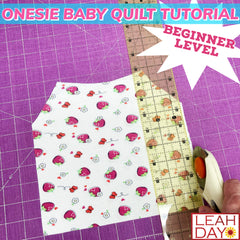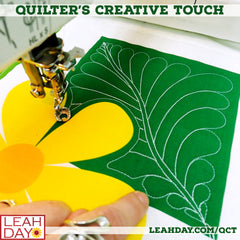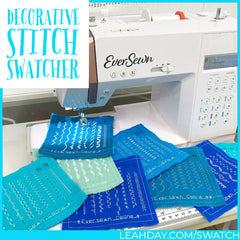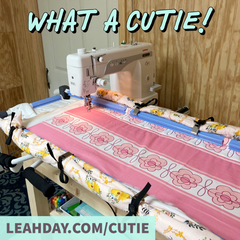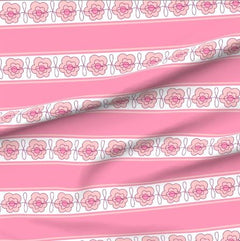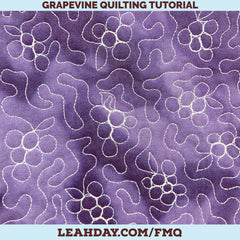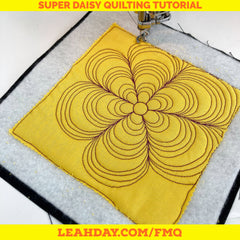Hello my quilting friends and welcome to this beginner quilting tutorial on Stitching in the Ditch, or Ditching as I like to call it! This quilting technique involves stitching in the seamlines, or ditches, between your pieced fabrics.
Learn how to stitch in the ditch in the Heart Medallion Checkerboard Quilt in this quilting video tutorial:
Click Here to find the quilting gloves I'm wearing in this video. The gloves help me grip the quilt and shift it into position easily. I find without the gloves, I tend to clench the quilt in my hands, which starts to hurt in a short space of time.

Getting a good grip on the quilt is important so you can keep it moving smoothly through the machine and allow the walking foot to do its job.

To Stitch in the Ditch or Stitch Slightly-Out-of-the-Ditch...This is Confusing!
There are many quilting techniques that are subject to quilting debate. One of the biggest debates is whether to stitch right in the ditch - right inside the seam joining two fabrics together - or slightly out of the ditch to one side or the other.
Quilting friendships have been lost, seam ripper wars have been waged, and the very fabric of the quilting community has been brought to its knees over this conflict. Just kidding - it's really not that big of a deal!
Like many things in quilting and patchwork, much of the debate comes from our hand piecing and hand quilting roots. Back in the day when you pieced fabrics together by hand, your stitches probably weren't very small or consistent. To ensure the big hand stitches weren't a liability, quilters would press seams to one side so the threads were tucked within the fold of the fabric.

This created a noticeable hump on one side of the ditch from the double layer of seam allowance, but that was considered better than pressing seams open, which might leave gaps between the hand stitches big enough for batting to leak through. Keep in mind, this was in a day when batting wasn't needlepunched, but raw cotton pulled apart and more or less evenly spread between the layers of cotton fabric.
To say it straight - a LOT has changed between now and then!
Most quilters these days a sewing machine for quilt piecing, which produces consistently spaced stitches that lock fabrics together. If you piece with a short stitch length like 1.5 mm, then you will lock your pieces together so firmly, they will be very challenging to rip apart.

With a short stitch length locking your pieces together, there is no issue with pressing your seams open and flat. The higher quality threads we use now are also significantly better than the threads our grandmothers used, so our patchwork is going to be pieced more durably than ever before.
But Can We Stitch RIGHT in the Ditch?
Again, this is subject to heated debates, but yes, I believe it's okay to stitch right in the middle of that ditch. This looks the best on the front and back of your quilt and is the easiest to explain and understand. The last thing I want to do is spend time staring at my quilt trying to figure out which side of the ditch I should stitch on. Stitch right in the ditch and you eliminate the question!
But what about stitches being cut by your needle as you ditch? What about batting leaking out between the stitches? Isn't this a recipe for QUILT DOOM?!

No, I don't think so. To explain: many quilters believe pressing seams open and stitching right in the ditch the needle may come down at exactly the wrong place and cut the threads holding your pieces together. If the threads break, there will be holes in the seam and batting can leak through, ruining the entire project. In other words: QUILT DOOM!
But come on! This is so unlikely, not to mention completely avoidable. By piecing with a tight stitch length of 1.5 mm, you will lock your pieces together so securely, even if the needle comes down exactly right, it's not going to create a hole in your quilt because of all the other stitches holding the pieces together.
Also consider the alternatives - pressing seams to one side which makes them bulkier which causes you to break needles as you machine quilt over it, which throws off the timing of your machine so now you can't piece or quilt anything until it's fixed. That to me is actually QUILT DOOM!
Ultimately I know this is a debate that will continue to be debated by quilters everywhere. There will always be those who prefer one technique over another and we all have reasons to justify our decisions.
The key with all quilting techniques is to try it and see what works for you.
If a certain technique helps you make a quilt better, faster, or easier, then stick with it. If a technique makes you want to tear your hair out, chuck it and move on!
Speaking of moving on, we have more tutorials in this series for you to enjoy! Click the links below to find the next tutorial in this series:
|
1. Stitching in the Ditch |
|
Click Here to learn how to make the Heart Medallion Checkerboard Quilt.
If you enjoyed this series, consider taking a quilting class with me! We have created many online quilting workshops to guide you through all the steps to creating beautiful quilts. You will love taking a quilt workshop because you get to see each step of the quilting process with great instructions!
Click Here to check out our online quilting workshops.






